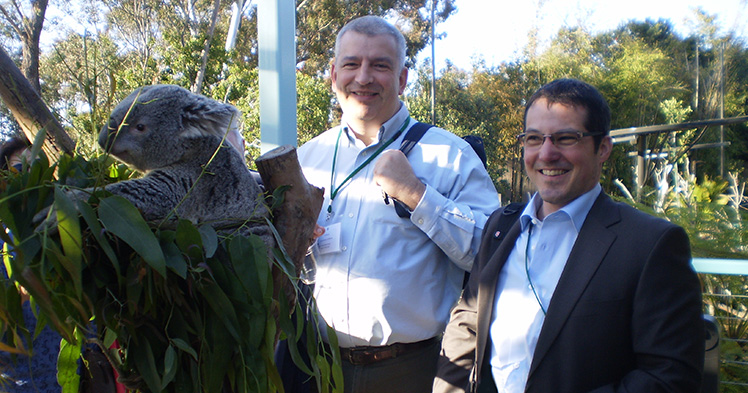Koala study reveals clues about origins of the human genome

Professor of Animal Sciences Alfred Roca (left) with Alex Greenwood of the Leibnitz Institute, Berlin at the San Diego Zoo.
In a recent study, published in Molecular Biology and Evolution, scientists from the University of Illinois discovered that 39 different KoRVs in a koala’s genome were all endogenous, which means passed down to the koala from one parent or the other; one of the KoRVs was found in both parents.
Koalas are the only known organisms where a retrovirus is transitioning from exogenous to endogenous. An exogenous retrovirus infects a host, inserts its genetic information into the cell’s DNA, and uses the host cell’s machinery to manufacture more viruses. When an exogenous retrovirus infects an egg or sperm cell and the viral genetic information is then passed down to the host’s offspring, the virus becomes an endogenous retrovirus (ERV).
Becoming part of the koala genome
Like humans, koalas have evolutionary defenses against endogenization.
“During the early stages of endogenization, there are huge numbers of retroviruses. KoRVs are present all across koalas’ genomes, with many thousands or tens of thousands of KoRVs in the population,” said Alfred Roca, a Professor of Animal Sciences and member of the Institute for Genomic Biology at the University of Illinois at Urbana-Champaign. “Over time most of them will disappear because these copies of the virus may be present in as few as one individual chromosome. If that one individual happens to not reproduce, or if it reproduces and the other chromosome is passed down, then that ERV will disappear.”
In order to end up with 100 ERVs in an organism, the species may have to start with 10,000 ERVs in its ancestors, Roca said. It takes retroviruses, like KoRV, many thousands of years to become a fixed part of the koala genome, like the eight percent of retroviral DNA that all humans share.
The ERVs that are successfully passed down are protected by the koala’s DNA repair mechanisms so that their rate of mutation is extremely low. Based on the dearth of mutations in the endogenous koala retroviruses, Roca’s team was able to estimate that the KoRVs integrated into the host germ line less than 50,000 years ago. “This is quite recent compared with other ERVs that are millions of years old and have accumulated mutations,” said first author Yasuko Ishida, a research specialist in Roca’s lab.
Overcoming retroviral fitness effects
In koalas, KoRV has been linked to leukemia, lymphoma, and immune suppression, which can lead to increased susceptibility to chlamydia.
“It seems likely that for thousands of years since this virus integrated, the koala host has suffered fitness effects,” Roca said. “It is possible that across species, when a host lineage has been invaded by ERVs, it had to go through this process of adaptation between host and virus, which is a very sad finding. It may be a very long, slow, painful process for the host species, one which human ancestors have gone through and overcome many times in the distant past.”
In mammals, retroviral DNA is associated with placental development and has been found to protect hosts from harmful exogenous retroviruses.
“But once retroviruses become part of the host, they begin to help the host because that is how they survive,” Roca said. “They will be better off if they evolve to protect the host. Over time, the detrimental effects go down and the beneficial effects go up.”
Conserving koala populations
In the 1900s, koalas were extensively hunted for their fur. In an effort to preserve koalas, a few individuals were moved to an island off the coast of Australia. Years later, the inbred island population was reintroduced to southern Australia. Today some of the southern koalas remain uninfected while almost all northern koalas have dozens of KoRVs in their genomes.
“Which is the lesser of two evils?” Roca said. “Do you try to conserve genetic diversity, which is present in the northern populations along with the retrovirus or do you conserve southern populations that don’t have the retrovirus but are horribly inbred?”
Roca’s research team included research specialist Yasuko Ishida, graduate student Kai Zhao, and scientific collaborator Alex Greenwood of the Leibnitz Institute in Berlin. Their work was supported by the National Institute of General Medical Sciences. The San Diego Zoo, Columbus Zoo, San Francisco Zoo, and Riverbanks Zoo provided the koala samples.
Written By: Claire Sturgeon. Photos by Kathryn Coulter and Yasuko Ishida
Media Contact
All latest news from the category: Life Sciences and Chemistry
Articles and reports from the Life Sciences and chemistry area deal with applied and basic research into modern biology, chemistry and human medicine.
Valuable information can be found on a range of life sciences fields including bacteriology, biochemistry, bionics, bioinformatics, biophysics, biotechnology, genetics, geobotany, human biology, marine biology, microbiology, molecular biology, cellular biology, zoology, bioinorganic chemistry, microchemistry and environmental chemistry.
Newest articles

Compact LCOS Microdisplay with Fast CMOS Backplane
…for High-Speed Light Modulation. Researchers from the Fraunhofer Institute for Photonic Microsystems IPMS, in collaboration with HOLOEYE Photonics AG, have developed a compact LCOS microdisplay with high refresh rates that…

New perspectives for material detection
CRC MARIE enters third funding period: A major success for terahertz research: Scientists at the University of Duisburg-Essen and the Ruhr University Bochum have been researching mobile material detection since…

CD Laboratory at TU Graz Researches New Semiconductor Materials
Using energy- and resource-saving methods, a research team at the Institute of Inorganic Chemistry at TU Graz aims to produce high-quality doped silicon layers for the electronics and solar industries….



